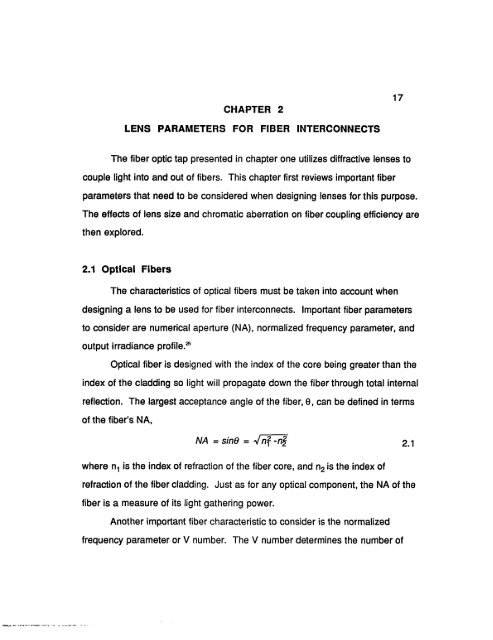azu_td_1349475_sip1_... - Arizona Campus Repository
azu_td_1349475_sip1_... - Arizona Campus Repository
azu_td_1349475_sip1_... - Arizona Campus Repository
Create successful ePaper yourself
Turn your PDF publications into a flip-book with our unique Google optimized e-Paper software.
CHAPTER 2<br />
17<br />
LENS PARAMETERS FOR FIBER INTERCONNECTS<br />
The fiber optic tap presented in chapter one utilizes diffractive lenses to<br />
couple light into and out of fibers. This chapter first reviews important fiber<br />
parameters that need to be considered when designing lenses for this purpose.<br />
The effects of lens size and chromatic aberration on fiber coupling efficiency are<br />
then explored.<br />
2.1 Optical Fibers<br />
The characteristics of optical fibers must be taken into account when<br />
designing a lens to be used for fiber interconnects. Important fiber parameters<br />
to consider are numerical aperture (NA), normalized frequency parameter, and<br />
output irradiance profile. 25<br />
Optical fiber is designed with the index of the core being greater than the<br />
index of the cladding so light will propagate down the fiber through total internal<br />
reflection. The largest acceptance angle of the fiber, 0, can be defined in terms<br />
of the fiber's NA,<br />
NA = sind ~ Vnf -nf 2.1<br />
where ^ is the index of refraction of the fiber core, and n 2 is the index of<br />
refraction of the fiber cladding. Just as for any optical component, the NA of the<br />
fiber is a measure of its light gathering power.<br />
Another important fiber characteristic to consider is the normalized<br />
frequency parameter or V number. The V number determines the number of
















